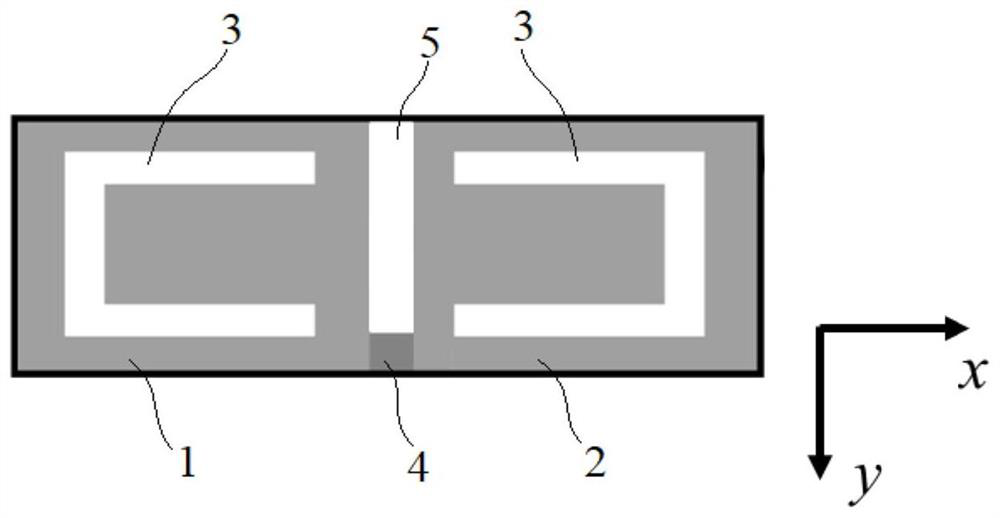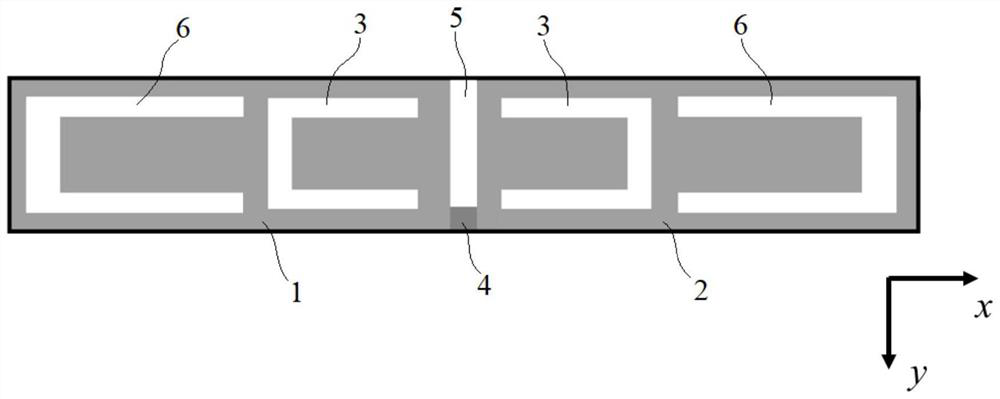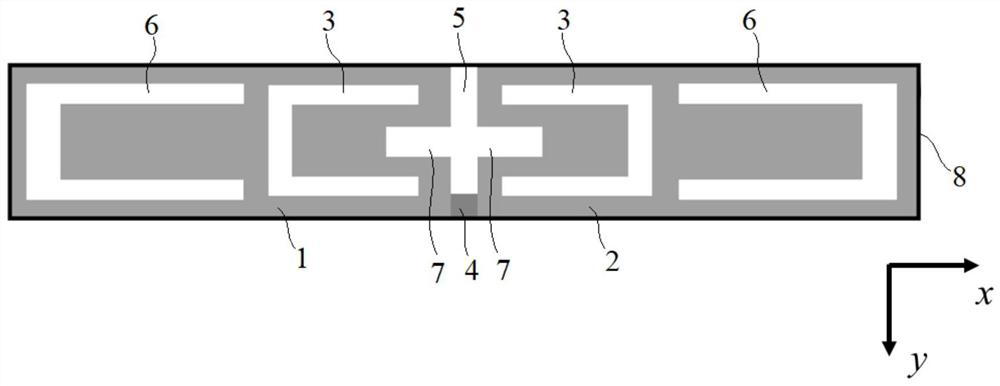Miniaturized dual-frequency antenna
A dual-frequency antenna and frequency technology, applied in antennas, resonant antennas, antenna components, etc., can solve problems such as narrow frequency band bandwidth, reduced radiation efficiency, and increased antenna structure, and achieve widened antenna bandwidth, high radiation efficiency, and antenna small size effect
- Summary
- Abstract
- Description
- Claims
- Application Information
AI Technical Summary
Problems solved by technology
Method used
Image
Examples
Embodiment 1
[0042] see figure 1 As shown, as an embodiment of a miniaturized dual-frequency antenna, it includes a first dipole arm 1 and a second dipole arm 2 that are symmetrical to each other, the first dipole arm 1 and the second dipole arm 1 The dipole formed by the sub-arm 2 is used to generate the first resonance point;
[0043] The first dipole arm 1 and the second dipole arm 2 respectively have a first U-shaped slot 3, the two first U-shaped slots 3 are symmetrical with each other and the openings are opposite to each other, the first U-shaped slot 3 for generating a second resonance point, the frequency of the first resonance point is different from the frequency of the second resonance point;
[0044] The two ends of the first dipole arm 1 and the second dipole arm 2 that are close to each other are respectively connected to the feeding structure 4. Optionally, the feeding structure 4 can be configured as a feeding metal sheet, or a For the feeding port, it is sufficient to c...
Embodiment 2
[0049] pass Figure 5 For the simulated reflection coefficient test results of the antenna of Example 1, it can be found that although the antenna of Example 1 has improved high-band bandwidth compared to the existing Wifi dual-band antenna, it still cannot form a better performance for 5-7.125GHz. coverage. Based on this, see figure 2 As shown, on the basis of Embodiment 1, as a further improvement solution, in the miniaturized dual-frequency antenna of this embodiment, the first dipole arm 1 and the second dipole arm 2 have one The second U-shaped groove 6, the two second U-shaped grooves 6 are symmetrical with each other and the openings are opposite to each other, the second U-shaped groove 6 and the first U-shaped groove 3 are located on the same axis; Specifically, the two first U-shaped grooves 3 and two second U-shaped grooves 6 to form a linear arrangement in the X-axis direction, the second U-shaped groove is located on one side of the vertical groove section of t...
Embodiment 3
[0054] pass Figure 5 For the simulated reflection coefficient test results of the antenna of Example 2, it can be found that although the high-frequency bandwidth of the antenna of Example 2 has been further widened relative to the dual-band antenna of Example 1, it still cannot satisfy the requirements for Wi-Fi - Higher frequency band bandwidth requirements proposed by Fi6 or Wi-Fi6E frequency bands. Based on this, see image 3 As shown, on the basis of Embodiment 2, as a further improvement solution, in the miniaturized dual-frequency antenna of this embodiment, the first dipole arm 1 and the second dipole arm 2 are close to each other. The two ends are respectively provided with a straight groove 7, and the two straight grooves 7 form a vertical orthogonal relationship with the gap 5 between the first dipole arm 1 and the second dipole arm 2; the straight grooves 7 is used to generate a fourth resonance point, and the frequency of the fourth resonance point is different...
PUM
 Login to View More
Login to View More Abstract
Description
Claims
Application Information
 Login to View More
Login to View More - R&D
- Intellectual Property
- Life Sciences
- Materials
- Tech Scout
- Unparalleled Data Quality
- Higher Quality Content
- 60% Fewer Hallucinations
Browse by: Latest US Patents, China's latest patents, Technical Efficacy Thesaurus, Application Domain, Technology Topic, Popular Technical Reports.
© 2025 PatSnap. All rights reserved.Legal|Privacy policy|Modern Slavery Act Transparency Statement|Sitemap|About US| Contact US: help@patsnap.com



